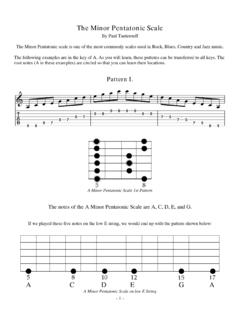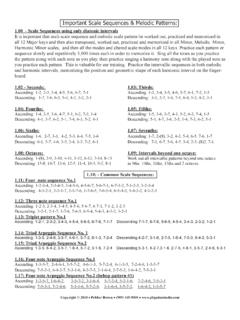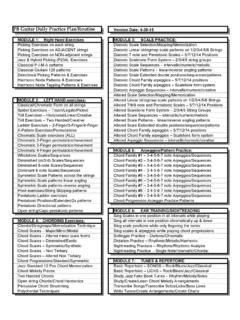Transcription of ULTIMATE GUITAR SOLOING CHEAT SHEET
1 ULTIMATE GUITAR SOLOING CHEAT SHEET - WRITTEN MANUAL - INTRODUCTION: This book of written lessons is an excellent tool and reference manual to develop and enhance your GUITAR skills. Use these instructional materials to help open up GUITAR avenues and to examine different chords and rhythms, lead GUITAR techniques, learning the fretboard, music theory,scales, and the world of playing over chord changes. If you don t keep a practice log you want to start one for sure. A three ring binder with filler paper works best. Print out this booklet of written lessons and keep it with all other music reference materials in the three ring binder. Keep these items handy so you can refer to them when studying and practicing. Add filler paper to your binder and keep accurate records in your practice log of the items you are working on, what needs work, chord changes, progressions, songs, original material, scales, etc.
2 Date the entries and keep track of your progress as you move forward in your GUITAR journey. Just like settings goals in life you want to set musical then go out there and achieve them. Remember to follow my structured curriculum, keep on practicing the right things, and keep developing your ear. Don t overwhelm yourself by trying to take on too many new things at once. Take these lessons and techniques in stages and slow and steady wins the race. Some of the more advanced lead GUITAR avenues will take time to digest. One of the keys is consistency. Keep trying to put those guitars in your hands every day, even if its only for 10-15 minutes. You don t necessarily need an hour block of time each day to learn GUITAR . Those little pockets of time where you have a spare ten minutes that you can practice really add up. Also make it easy for yourself to practice. Buy a GUITAR stand and keep your GUITAR out on the stand so it is accessible to you at all times.
3 Keep the GUITAR on the stand in a room you are in the most. This way you will be much more likely to grab it and practice when you have that free ten minute pocket of time. Don t keep your GUITAR packed up in its case under your bed or packed away in the closet. Leave it out and make it accessible. Like with anything new and different on the instrument dive into these materials with an open mind. Know that if you practice these techniques, work hard, keep honing your skills and refining your art that these methods will bring you results. Stay positive and remember that your GUITAR playing is an evolution..now let s get to it! Page 2 of 29 Copyright GuitarJamz Inc. - All rights reserved unauthorized duplication or distribution of any part of this book is prohibitedTABLE OF CONTENTS: Written Lesson Page Introduction .. 2 Table of contents .. 3 Getting started .. 4 Chords Dominant 7th chords .. 5 Notes on the fretboard.
4 6 Lead GUITAR rhythm, the ride, note choice, & phrasing .. 7 Lead GUITAR the big Four .. 8 The choices when SOLOING .. 9 Key Signature and chord analyzing .. 10 Example progressions and SOLOING options Major Key .. 11-12 Example progressions and SOLOING options minor Key .. 13 The minor pentatonic scale .. 13 The minor pentatonic Expanded I scale .. 14 The minor pentatonic Expanded II scale .. 15 The minor pentatonic scale five box scales .. 16 The Major P entatonic scale .. 17 Major pentatonic Sus4 scale .. 18 Major pentatonic Sus4 scale links .. 19 Top ten key hints to get your playing to the next level .. 20-22 Chord construction .. 23-24 Circle of fifths .. 25 Blank tablature staff paper (document your favorite licks & riffs) .. 27-29 Page 3 of 29 Copyright GuitarJamz Inc. - All rights reserved unauthorized duplication or distribution of any part of this book is prohibitedGETTING STARTED Keep in mind that I want to give you the most complete GUITAR curriculum possible.
5 This does not mean you have to master every lead GUITAR avenue or scale before moving on to the next. In these materials I teach many lead GUITAR avenues. Some will be more challenging than others and of course take more time to learn and apply. But over time you will find the principles and techniques start to sink in and eventually will become automatic. With all the materials out there today and with the ease of locating materials online it sure can be overwhelming. So remember not to take on too much at once or you will become overwhelmed and frustrated. Slow and steady wins the race. You don t want to rush things and then end up skimming over important topics leaving voids in your playing. It s important to take the extra time to learn about the why things work as I write out in the lessons throughout this book. Learning the why things work will give you the musical knowledge to blast these principles and techniques across all your playing.
6 It will give you the lead GUITAR confidence to be able to instantly know what avenues are possible when SOLOING and improvising. That s the trick, to use these lessons as templates or vehicles to learn the why things work, and then develop them into your GUITAR arsenal through practical application. Then you have the tools to blast thes playing techniques across all your playing at any given time, in any given jam, and in any given song. Don t forget that as you further develop your lead GUITAR skills you also want to keep practicing and developing your rhythm skills. Your rhythm and timing are critical elements to your overall abilities on the GUITAR . Never forget that your lead playing will really only ever be as good as your rhythm playing. As I dive further and further into lead GUITAR techniques and concepts in this book, keep in mind that these very systematic and methodical techniques will seem a bit daunting at first.
7 However, these will soon become second nature and automatic, they will become engrained in your playing style. You wont have to think about what to play so much as it will eventually become second nature. Then you will be letting your ear take you to all the right notes and chords and not having to think about techniques and application so much but rather focus on emotion and feel in your playing. The more you practice and apply these materials the faster you will be on autopilot . That said, throughout my teaching career I have found that first learning things systematically will get your playing to the next level the fastest. Remember we are building your GUITAR chops and you need to have that solid foundation to build upon as you move along in your GUITAR journey. Because many blues progressions utilize I- IV-V chord changes you will often be utilizing minor pentatonic & Blues and/or Major pentatonic as potential lead playing avenues.
8 pentatonic scales are killer scales to play over blues and over I- IV-V changes. They just ooze that minor bluesy vibe or sweet major vibe. Many big name players and rock bands have made careers using pentatonic scales. However, I urge you to try some of the other suggestions that I list, don t limit yourself. You will also want to eventually learn the modes of the major scale . Modes like Dorian, Aeolian, and Mixolydian can sound awesome over Blues progressions when utilized properly. KEY POINT: Keep in mind that at this stage of your lead GUITAR playing journey there is just no substitute for practicing the right things, learning scales, studying the sounds and relationships between chords and scales, developing your ear, practicing and honing your skills using jam tracks, and continually pushing yourself and refining your art. Remember that your GUITAR playing is an evolution. Stay positive, keep with it, swing for the fences, and also give yourself plenty of fun time on the GUITAR to go along with all the hard work and studying.
9 YOU CAN DO IT! Page 4 of 29 Copyright GuitarJamz Inc. - All rights reserved unauthorized duplication or distribution of any part of this book is prohibitedNOTES ON THE FRETBOARD 6 Low E 5 4 3 2 1 High E A D G B Edie Ate Dynamite Good Bye Edie# = SHARP b = FLAT F Bb Eb G# C F 1st Fret F# B E A C# F# G C F Bb D G 3rd fret G# C# F# B Eb G# A D G C E A 5th fret Bb Eb G# C# F Bb B E A D F# B 7th fret C F Bb Eb G C C# F# B E G# C# 9th fret D G C F A D Eb G# C# F# Bb Eb E A D G B E The twelve-note scale consists of: A, Bb, B, C, C#, D, Eb, E, F, F#, G, G# A and G strings are related from any note on the A string go 2 strings down and 2 frets over and you have the same note an octave higher on the G string E and D strings any note on the E down and 2 frets over and you have the same note an octave higher on the D string Low E and High E strings have same note names on each fret just two octaves apart Page 5 of 29 Copyright GuitarJamz Inc.
10 - All rights reserved unauthorized duplication or distribution of any part of this book is prohibitedLEAD GUITAR - Rhythm, The Ride, Note Choice, & Phrasing Lead playing is something that can identify a player like a signature or fingerprint. Players like Stevie Ray Vaughan, Eddie Van Halen, BB King, Eric Clapton, Eric Johnson, Steve Vai, and Carlos Santana can be identified with a single note. They have a very signature sound and identifiable GUITAR tone. As you continue your lead GUITAR studies and keep up with your practicing, you will find your playing will evolve over time your playing is an evolution. An element of lead playing which may seem simple, like vibrato or string bending, can takes months and months to develop into a signature statement in your lead GUITAR bag of tricks. GEAR/EQUIPMENT Sometimes guitarists think that if they purchase the same GUITAR , amp, and effects of their favorite guitarist that they will cop their signature sound and replicate their tone.








